Pier Diary
Pier Timeline
1802.
First
small
jetty
built,
at
the
western
end
of
the
path
below
the
Shrubbery,
for
the
convenience
of
those
who
made
use
of
the
pleasure boats.
1828.
Meeting
of
local
landowners
called
to
discuss
how
to
improve
the
amenities
of
Southend,
one
of
the
proposals
was
to
construct
a
new
pier
and
jetty
or
causeway
from
the
shore
to
deep
water
where
the
flag
will
be
hoisted
and
a
light
constantly
burning
at
night,
so passengers and goods may be landed at all times of the tide without delay, inconvenience and risk of accident.
1829, 14th May. The first Pier Act received Royal Assent.
1829, June. Building material for the wooden pier are washed out to sea during a gale.
1829, 25th July. Lord Mayor of London lays the foundation stone of the first section of the new structure.
1830, June. The first section of the wooden pier, which did not exceed 1,500 feet in length was opened.
1834.
The
loading
pier
called
the
“Lighthouse”
or
“The
Mount”
opened
replacing
Clarence
the
100ft
vessel
moored
in
the
deep
channel.
1835. Plans to extend the pier again to the deep water channel in the estuary.
1835. The pier is first marked on the Admiralty chart, as the result of a survey in 1834-1835.
1835. Carts used on the pier.
1846.
Extension
completed,
the
pier
runs
from
shore
to
the
deep
water
channel.
Southend
claims
to
have
the
longest
pier
in
Europe,
length was now 1 mile and a quarter in length, with a tramway that runs the length, the car being drawn by two horses.
1846. Pier sold by the mortgagees to developers of Cliff Town for £17,000.
1846, September. Naval officer falls from the promenade into the sea, luckily he was rescued.
For the next ~28 years the pier had various owners.
c1874. Pier offered to the Southend Local Board for £12,000 eventually sold for £10,000.
1877. Southend Local Board vote to build new pier and is authorised by an Act of Parliament.
1877. First yacht race around the UK, starts and finishes at the pier.
1879. First lifeboat is stationed on the pier.
1881. January. Pier damaged during a great storm.
1881. The Barge West Kent owned by Messrs. Vandervord hits the pier, a large portion was carried away.
1881. Horse drawn tramway closed, horses kept putting hoofs through holes/gaps in planking.
1883, 30th July. Commercial maritime signalling for Lloyds of London set up on the pier head.
1885. New Pier Entrance Toll House erected.
1885. Construction starts on the new iron pier next to the original wooden pier.
1887. Pier extended by 150 yards.
1887, 29th March. Act of Parliament passed for new iron pier.
1887.
1st
September.
At
the
request
of
the
General
Post
Office
the
signal
station
at
the
pier
head
commenced
to
function
as
a
public
telegraph office later being rehoused to a new signalling station on the new extension.
1888.
Southend
becomes
a
Borough
the
new
Town
Council
faces
gradual
silting
up
of
the
channel
at
the
pier
Head.
This
problem
was
met with an extension of the new pier and new pier head costing £21,000.
1889.
First
section
of
the
new
iron
pier
is
completed
and
opened
to
the
public.
This
was
the
first
pier
in
England
to
have
an
electric
railway, the old Toast-Rack tram ran on a single track.
1890,
May.
The
old
pier
was
not
to
go
without
excitement.
As
its
structure
was
made
of
wood
It
was
not
unusual
for
outbreaks
of
fire
to
occur.
Up
to
this
date
they
had
all
been
easily
dealt
with
a
bucket
or
two
of
water.
Some
fifty
yards
of
decking
was
destroyed
on
the
last
Sunday
in
May.
The
following
Thursday
the
old
pier
was
on
fire
again
nearly
a
quarter
of
a
mile
of
planking
was
destroyed.
The
efforts
of
the
firemen
was
hampered
because
this
section
of
the
old
pier
was
loaded
with
materials
used
for
the
building
of
the
new
pier
structure.
The
reflection
was
seen
for
miles,
and
took
some
hours
for
the
outbreak
to
be
subdued.
The
fire
created
much
alarm
among the townspeople.
1890, 24th August. Newly constructed iron pier officially opens to the public although still incomplete.
1891.
Pier
train
becomes
popular,
pier
officials
employ
a
plain
clothes
inspector
to
catch
people
making
false
accident
claims
against
the pier operators.
1893. Six more cars added to fleet allowing two trains of six, one in service the other on stand by, passing loop installed.
1893. Work begins on erecting extra of piles along the east side of the pier.
1895, July. Pier sliced in two by a lighter barge owned by the Thames Lighterage Company during a gale.
1896-1897. Construction of pier extension starts due to silting up of the Thames.
1898. Formal opening of the new extension and pier head.
1898 Article from a Southend Guide on the new iron pier
THE
PIER
has
a
wide
platform,
and
visitors
are
charged
one
penny
each
for
promenading
upon
it.
A
tramway
also
runs
down
one
side.
It
is
one
of
the
favourite
promenades
of
the
place,
and
is
usually
well
attended
by
pedestrians
and
anglers,
who
attach
baited
lines to the side rails and catch or attempt to catch many kinds of fish.
CAPTAIN
KELLY
was
elected
Pier
Master,
March
1891.
The
Revenue
from
the
Pier
the
year
before
his
appointment
was
£5,250,
but
it
was
anticipated
that,
with
good
management,
it
would
reach
£7,000,
but
as
a
matter
of
fact
it
reached
£9,340,
and
the
year
ending
Lady
Day,
1896,
it
was
£13,579,
which
again
was
exceeded
the following year and reached no less a sum than £14,300.
His
duties
are
great
and
he
does
them
well.
He
has
sole
charge
of
the
Pier
and
its
approaches,
the
loading
pier
jetties,
beach
and
foreshore,
all
plant,
goods
and
properties,
the
proper
conduct
of
trams,
and
he
has
to
report
on
all
applications
for
licenses,
the
collection
of
rents
and
tolls,
and
to
check
and
certify
all
accounts.
The
Corporation
has
not,
probably,
a
more
hard
working
servant.
Should
he
ever
retire,
it
will
be
a
difficult
matter
to fill his place.
THE
PAVILION
is
capable
of
seating
1,200
people,
it
has
an
excellent
stage,
and
during
the
season
performances
are
given
daily,
afternoon
and
evening.
The
electric
light
is
used
to
illuminate
the
pier
and
Pavilion.
About
a
quarter
of
a
mile
apart
shelters
have
been
erected
for
resting
purposes,
should
rain
or
fatigue
overtake
one
while
strolling
down.
At
the
extreme
are
Lloyd’s
offices
and
a
flagstaff
which
is
used
for
signalling
purposes;
there
are
also
a
refreshment
room,
lighthouse,
cloakroom,
etc.
There
is
also
a
landing
stage for the steamers which arrive daily form London, Sheerness, Chatham, and Rochester, during the summer months.
THE
NEW
PIER
EXTENSION
was
constructed
in
the
years
1896-97
by
the
Corporation,
at
a
cost
of
£20,000,
for
the
purpose
of
giving
greater
facilities
and
safety
to
the
Steamboat
Passengers
(numbering,
landing
and
embarking,
last
season
211,000)
and
also
to
give sufficient water to the larger class of steamers now plying.

Southend Timeline Southend-on-Sea © 2009 - 2024. All Rights Reserved
Building the first wooden pier
In
the
year
1814
the
first
passenger
steamer
completed
a
voyage
from
London
to
Margate
on
the
River
Thames.
That
day
was
an
important
one
for
the
little
Kent
town
for
until
then
the
only
means
of
transport
had
been
the
stage
coach
or
sailing
boat.
It
would
be
twenty
years
or
more
before
visitors
could
travel
by
railway
and
it
was,
therefore,
not
surprising
that
the
steamboat
service
was
an
immediate success. So much so that in 1825, only 11 years later, steam vessels carried 50,000 people on the Margate run.
People
who
were
interested
in
developing
Southend
as
a
“watering
place”
became
alarmed
at
the
prosperity
which
the
steamboat
was
bringing
to
Margate.
Tidal
conditions
at
Southend
did
not
permit
even
a
small
steamer
to
disembark
passengers
close
to
the
shore
except
at
high
water
and
it
was
evident
that
if
Southend
was
to
survive
as
a
holiday
resort
the
provision
of
better
landing
facilities
was
essential.
There
were
local
pleasure
craft
and
barges,
owned
by
Mr.
Mayall,
Mr.
Cockerton,
and
Mr.
Vandervord;
however,
apart
from
short
jetties
and
‘hards’,
no
pier
existed
for
passengers
and
goods
landing
at
low
water.
A
group
of
local
landowners,
who
could
foresee
the
benefit
of
increased
trade
and
traffic,
met
at
the
Royal
Hotel,
and
proposed,
among
other
things,
that
a
pier
should
be
erected.
Therefore
an
Act
of
Parliament
was
to
be
sought,
prompted
by
by
Sir
William
Heygate,
one
of
the
local
landowners,
former
resident
of
Royal
Terrace,
and
former
Lord
Mayor
of
London.
The
scheme
was
to
be
financed
through
subscriptions
and
shares,
and
the
money
recouped
through
toll
charges
on
goods
and
people.
After
some
arguments,
and
various
objections
the
pier
would
start
at
the
foot
of
Royal
Terrace
ridge,
with
a
toll
house
erected
at
its
entrance.
On
the
east
side
of
the
pier
would
be
a
harbour,
consisting
on
little more than breakwater.
The
first
section
of
the
pier,
some
1,500ft
in
length,
was
opened
in
1830
and
was
built
almost
entirely
of
wood
and
eventually
continued
until
it
extended
to
about
half
a
mile
from
the
shore.
As
the
tide
receded
beyond
this
point,
passengers
desiring
to
embark
had
to
proceed
from
here
on
foot
or
by
cart
along
a
hard
way
of
shingle
for
a
further
quarter
of
a
mile
where
they
were
faced
by
a
stretch
of
water
over
which
they
had
to
be
ferried
in
small
boats
to
the
pier
head
in
the
deep
water
channel.
This
was
at
first
an
old
vessel
named
“Clarence“
about
100ft
in
length,
later
replaced
by
a
structure
of
piles
called
the
“The
Lighthouse”
or
“The
Mount”.
Nevertheless
in
spite
of
its
inconvenience
a
daily
service
of
steamboats
from
London
was
soon
in
operation
and
excursions
were
run to Herne Bay.
The
building
of
the
pier
was
not
only
the
project
for
which
the
Pier
Company
had
received
Parliamentary
sanction,
but
included
also
the
provision
of
a
proper
harbour
for
barges,
etc.,
on
the
east
side,
the
making
up
of
Pier
Hill,
the
construction
of
a
road
by
the
sea
to
Shoeburyness
and
also
a
road
to
Prittlewell.
But
by
1835
all
the
money
had
been
spent,
the
pier
was
incomplete
and
no
roads
had
been
made.
Further
application
to
Parliament
was
necessary
and
as
a
condition
of
sanctioning
the
raising
of
further
capital,
the
company
were
required
to
carry
the
pier
to
deep
water.
This
was
accomplished
in
1846
and
Southend
could
then
claim
to
have
the
longest
pier
in
Europe,
the
completed
structure
being
a
mile
and
a
quarter
in
length.
It
was
built
entirely
of
wood,
the
first
600ft
having
a
width
of
20ft
beyond
which
the
promenade
gradually
diminished
to
a
minimum
width
of
8ft.
A
tramway
ran
the
length
of
the
pier,
the
car
being
drawn
by
two
horses
driven
tandem
fashion.
The
pier
head
was
102ft
in
width,
had
three
berthing
places
for
steam
and
sailing
vessels,
which
enabled
passengers to land and embark at all states of tides.
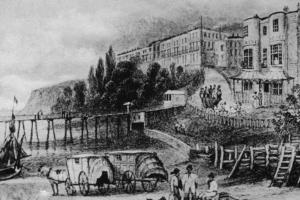
1830 The Pier and Pier Hill
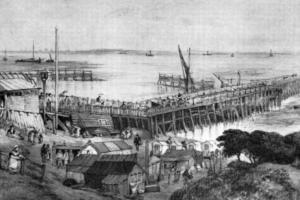
The original Pier with harbour
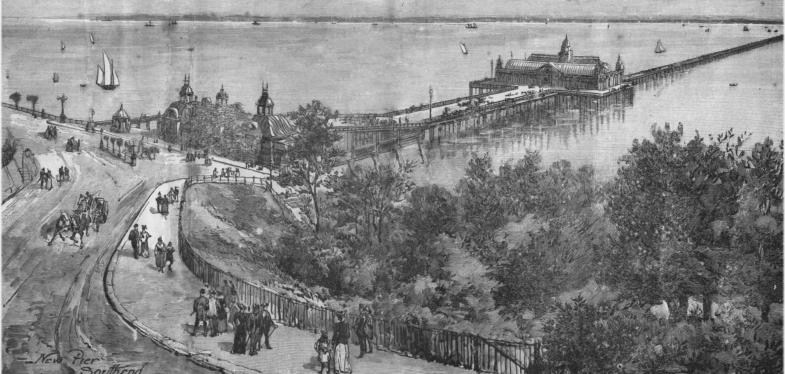
1898 The Iron Pier with entrance Toll House and Pavilion
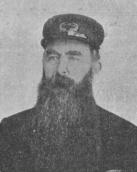
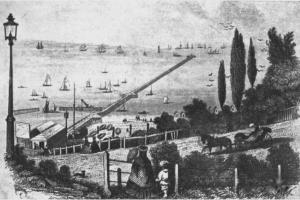
The original Pier with harbour and octagon
platform
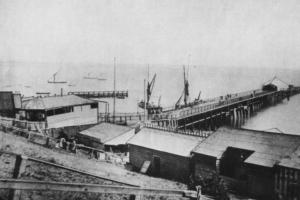
The original Pier with covered octagon platform
1898, 10th December. Nearly 100ft of the pier is wrecked by the ketch Dolphin causing damage at a cost of over £1,000.
1899, 28th July. Passing loop opened.
1899. Passing loop extended, 2nd Generator installed on pier.
1900, March & December. Pier wrecked by vessels causing damage to the structure.
1902.
Water
chute
opens
left
to
the
pier
entrance,
this
was
in
built
part
of
the
old
harbour
only
to
be
replaced
quite
soon
afterwards
by a boating pool.
1902. Dedicated Pier Generating Station built in London Road.
1902. Trains re-fitted with 18hp engines.
1902. Four more cars added to fleet total 16 cars making four trains of four cars.
1903. Proposals announced for a “sister” pier at Westcliff.
1907. Permission granted for extension of the railway & covering of pier head station.
1907,
14th
December.
Pier
hit
by
the
barge
Robert,
laden
with
hay
causing
a
60ft
gap,
damage
was
to
the
western
promenade
side
near the old Pier head over twelve piles were broken.
1908. The Southend Fire Brigade carries out exercise on the pier and win the National Fire Brigade Championship.
1908, 25th July. Upper Promenade Deck pier extension opened by Mayor Alderman J. C. Ingram.
1908,
23rd
November.
Thames
Conservancy
hulk
Marlborough
broke
from
her
moorings
in
a
gale
and
was
carried
through
the
promenade between the old and new pier heads destroying 60ft of decking.
1909. Four more cars added to fleet (4 trains of five cars) all trains upgraded with BTH 27hp motors.
1909, 12th July. Barge Alzima hits the pier between third & fourth shelters with slight damage.
1909, 16th July. Home & Atlantic Fleets muster off the pier for the Grand Fleet Review.
1909, 17th July. Grand Fleet Review, the review consisted of 150 ships.
1910. Conductor rails replaced with 45lb/yard steel rails, train pick-ups replaced with iron ones.
1910. GE27 hp motors fitted to trains, more cars added to fleet total 28 four trains of five cars.
1913.
Four
more
cars
added
total
32
four
trains
of
seven
cars,
also
added
two
petrol
driven
cars
for
winter
use
each
holding
250
people, passenger numbers 844,460 people carried.
1914. Passenger Steamer traffic at 10 a day.
1914. Admiralty takes over the signal station pier head.
1914,
November.
Three
prison
ships
moored
off
the
pier
holding
German
soldiers
and
civilians.
Due
to
safety
concerns
in
spring
1915
prisoners were moved away to other camps.
1915, March. Captured German U-boat exhibited at pier head.
1916, March. Zeppelin L15 shot down East of Pier.
1917, August. Plane crash lands on pier causing light damage.
1918, May. Diving demonstrations given from pier.
1919.
Railway
track
found
to
be
of
poor
condition,
new
running
rails
fitted
along
with
new
conductor
rail,
passenger
numbers
1,524,120 people carried.
1919,
25th
March.
The
first
of
the
German
Merchant
Fleet
arrives.
The
ships
were
to
be
surrounded
to
the
allied
forces
in
accordance
with the armistice, it takes three weeks for the fleet to gather.
1919, 17th July. 1st & 2nd Battle Squadrons & Battle Cruiser Squadron of the Pacific Fleet muster off the pier for Grand Fleet review.
1919, 19th July. Grand Fleet Review.
1919, September, German Submarine “Deutschland” 10 day visit.
1921,
18th
January.
Pier
broken
in
two
when
the
concrete
motor
ship
Violette
went
through
the
pier
between
the
last
shelter
and
the
old pier head. Piles were broken for about 160ft, decking and tramway etc had to be replaced.
1921. Red lights installed along the length of the pier to warn sea craft of structure.
1921, 14th July. Pier reopens. King George V visits Southend for yachting week.
1923, Magnetic Breaking System fitted to one train for evaluation.
1924. Magnetic Breaking System abandoned, all trains have running wheels replaced with Bessemer Steel wheels.
1926, September. Steamer Boat Service tops 25 a day.
1927. Upper pier deck extended.
1928. Midway passing loop extended by 150 yards, new loops at North (shore) station and South (head) station installed.
1928,
20th
September.
Pier
train
crash.
At
around
4:00pm
the
shore
bound
train
was
passing
the
entrance
to
the
midway
loop
when
the
last
two
cars
were
struck
by
the
leading
(drive)
car
on
the
head
bound
train.
The
two
cars
were
both
knocked
off
the
rails
being
forced
upon
to
the
handrails
separating
the
railway
from
the
walkway,
both
cars
received
considerable
damage
to
such
an
extent
that
they
were
both
written
off.
A
unique
safety
feature
of
Southend
Pier
was
the
Automatic
Electricity
cut
off
in
event
of
an
accident.
In
all,
seven
cars
were
damaged
twenty
feet
of
handrails
needed
replacing
and
the
main
water
supply
to
the
pier
head
was
ruptured.
An
emergency rail service was up and running within three hours, there were no serious injures.
1929, 7th July. Prince George extension opens at the cost of £57,700.
1930. Improvements to railway track start.
1931. The old entrance toll house is demolished.
1931. Louis Tussauds waxworks opens next to entrance of the pier.
1931, 7th June, Mr. Ernest Turner fell from and was run over by one of the electric trams on the railway. He was killed instantly.
Mr.
Turner,
who
was
38
at
the
time,
was
one
of
a
party
of
over
500
workers
and
family
members
on
the
annual
works
outing
from
Ansell's
brewery
in
Birmingham,
where
he
worked
as
a
Brewer's
Drayman.
The
party
had
arrived
at
the
pier
having
travelled
down
the
River
Thames
from
Tower
Pier
in
London
where
they
had
arrived
earlier
that
day.
It
was
whilst
travelling
from
the
pier
head
that
the
accident
occurred.
At
the
inquest,
which
was
held
two
days
later,
the
Southend-on-Sea
Coroner,
Mr.
H.
J.
Jefferies,
determined
that
there
were
no
extenuating
circumstances
and
the
jury
returned
a
verdict
of
accidental
death.
At
the
time
of
his
death
Mr.
Turner
was married to Elsie and was father to their daughter Ivy who was just 4 years old.
1931. Semi-automatic colour light signalling begins operation.
1932. Further extension work carried out the pier becomes the worlds longest at 1.49 Miles (2.4 kilometres).
1933,
17th
March.
Pier
damaged
by
Matilda
Upton
barge
in
a
gale,
about
20
yards
of
the
promenade
deck
was
damaged
costing
£3,000 to repair.
1933, 16th April. Pier railway reopens as a two track system.
1935, January. First launch from the new lifeboat station.
1935, May. Home Fleet visit for King George V Silver Jubilee.
1935,
23rd
July.
The
Pier’s
centenary.
Unveiling
of
a
tablet
on
the
boathouse
and
official
opening
of
the
slipway
by
the
Chairman
of
the
Port
of
London
Authority
Lord
Ritchie
of
Dundee.
The
new
lifeboat
house
was
located
on
a
raised
platform
on
a
spur
to
the
east
of
the
pier,
the
lifeboat
was
launched
into
the
sea
via
a
slipway.
The
lifeboat
house
would
serve
until
1986
when
it
was
damaged
beyond repair by the Kings Abbey accident.
1937. Man falls from pier train landing on sand below.
1937, May. Visit of the Home Fleet for the Coronation of King George IV.
1939,
25th
August.
Southend
pier
is
taken
over
by
the
Royal
Navy
and
becomes
HMS
Leigh.
Southend
becomes
the
headquarters
of
the
Thames
and
Medway
Control.
The
Army
thought
is
was
tempting
to
an
invader.
Two
hundred
Pioneers
lived
on
it
months.
Pill
boxes
were
built
beyond
the
pavilion.
Depth
charges
and
chutes
and
U.P.
rockets
were
installed
on
the
pier
head.
A
special
upper
deck
was
built
on
the
Prince
George
Extension
and
mounted
anti
aircraft
guns
in
concrete
emplacements
from
which
fine
work
was
done against the Luftwaffe and flying bombs.
1939, 9th September. Pier closes to the public.
1939, 22nd November. Southend Pier and anchorage attacked from the air by the Germans.
1939-1945.
V2
hits
the
pier
pavilion,
rocket
went
through
the
roof
then
the
floor
before
embedding
its
self
in
the
mud
below,
luckily
it
failed to detonate.
1940,
August.
Heinkel
He111’s
stick
bomb
the
pier.
Stick
bombing
was
when
the
bombers
flew
in
line-a-stern
and
dropped
their
bombs in one long line.
1941, February. Pier station hit by bomb slight damage.
1945, 17th May. After restoration to peace time condition, the full length of the pier is opened to the public.
1946. Passenger numbers reach 2,750,000.
1946, June—October, British & American battleships visit.
1947. Passenger numbers 3,310,922, trains in service for a solid 45 years.
1947, June—October. British & American battleships visit.
1949. End of life for Toast Rack carriages, it is reported they had travelled in excess of 3 million miles carrying 65 million people.
1949, March. New railway carriages delivered.
1949, April. Inauguration of the new pier electric trains by Lord Broadbridge, Lord Mayor of London.
1949/1950, Season. The pier sees some 4,713,000+ people use the train with a further 1million+ down the walkway.
1950. The Dolphin Restaurant is built.
1950, 20th May. Pier railway Jubilee Season.
1951, June. Swedish Naval Training Squadron visit.
1951,
10th—15th
July.
The
Colossus
class
light
fleet
aircraft
carrier
HMS
Vengeance
visits
the
pier
for
the
Festival
of
Britain
over
15000
people
visit
the
ship.
HMS
Vengeance
was
visited
by
more
than
15000
people
over
the
week-long
stay,
she
was
moored
just
off
the
pier.
The
Colossus
class
carrier
was
loaned
to
the
Royal
Australian
Navy
between
1952—1955
because
of
delays
during
the
modifications
to
the
Australian
carrier
HMAS
Melbourne.
Once
the
work
on
the
Melbourne
was
completed,
Vengeance
was
returned
to
the
Royal
Navy.
Vengeance
was
sold
to
Brazil
in
1956
becoming
the
“Minas
Gerais,”
in
2000
the
new
Brazilian
carrier
NAe
Sao
Paulo
entered
service
the
cost
of
operating
two
carriers
and
the
fact
that
Vengeance
could
only
accommodate
12
modern
jet
fighter
saw
the
ageing
Vengeance
offered
to
the
Argentine
Navy,
however,
the
cost
of
bringing
the
carrier
up
to
standard
to
fly
jets
again
was
too
high,
she
was
converted
into
a
helicopter
support
ship.
Vengeance
was
finally
decommissioned
on
16th
October
2001
bringing
to
an
end
the
era
of
the
Colossus
class
aircraft
carrier.
In
2002
Vengeance
was
auctioned
off,
the
highest
bid
was
from
Hong
Kong
who
wanted
to
anchor
her
in
Zhoushan
China
and
convert
her
into
a
floating
museum,
however,
the
deal
fell
through
in
October
2003,
Vengeance was scrapped some time later.
1953. HMS Vanguard visits Southend.
1953. Pier entrance gets a special Royal Archway to celebrate the 1953 Coronation.
1959, October. The pier pavilion is destroyed by fire.
1963, September. Medway Queen paddle steamer makes her last visit.
1964. New bowling alley built on the site of the pavilion.
1969, 8th August. Fire in the Dolphin Restaurant, pier head.
1969. Steamboat service from the pier head is suspended.
1970. Californian Consortium offer to buy for £12.5 million and move the pier to the USA.
1971. A child falls through rotten decking prompting the start of a total rebuild of the deck.
1971, 11th August. Fire in storeroom & disused restaurant pier head.
1972.
Mitchell
Ropeways
propose
to
replace
the
train
with
the
Swiss
designed
Aerobus
suspended
monorail.
The
proposal
would
have
seen
pylons
placed
alongside
the
pier
linked
by
a
steel
cable,
the
service
would
of
run
two
100seater
“Aerobuses”
hung
from
the
cable
like a cable car.
1973. The Save Southend Pier Action Group is set up.
1973, December. The pier becomes grade 2 listed.
1974. Pier railway goes back to single track operation.
Mid
1970s.
Pier
railway
crossovers
&
signalling
removed.
This
saw
two
trains
permanently
dedicated
to
one
track
each
cars
1,
2,
3,
4,
5,
6,
&
7
operate
on
the
East
track
(waterside)
whilst
cars
17,
22,
23,
24,
25,
28
(re-numbered
8-14)
serve
on
the
West
track
(walkway
side).
The
two
other
seven
car
trains
are
permanently
withdrawn
from
use
these
being
Cars
8,9,10,11,12,13,14,
and
cars
15,16,18,19,20,21,26.
Car
8
was
re-built
as
a
flat
works
wagon,
whilst
cars
11,14,15,20,21
were
retired
and
placed
in
store
at
the
Councils Camper Road Dept the rest were scrapped. The pier head facilities are leased out to a private leisure & catering firm.
1976,
25th
March.
RNLI
lifeboat
"Greater
London"
retired
and
all
sea
going
lifeboat
operations
are
ceased
due
to
the
silting
up
of
the
River Thames around the lifeboat slip-way.
1976,
29th
July.
Fire
destroys
the
pier
head.
Fighting
the
fire
saw
some
50,000
gallons
of
water
pumped
on
to
the
fire
by
two
fire
tugs,
these
were
later
joined
by
five
more,
Ladi
Mormol
dive
bombed
the
pier
with
his
crop
spraying
aircraft
dumping
400
gallons
of
water
at
a
time
on
the
inferno
swooping
down
to
100ft,
the
flames
were
at
time
leaping
100+
foot
into
the
air,
500
people
had
to
be
rescued
by
the
pier
trains.
From
all
the
people
on
the
pier
at
the
time
of
the
blaze
only
two
fire-fighters
were
injured,
this
was
when
they jumped from a single sortie building to get out of the way of the rifle range bullets that were spontaneously going off in the heat.
1977. A number of ornamental railings are removed from the pier and sold to the owner of the original London bridge in the USA.
1977, May. Remaining pier head businesses reopen.
1977, May. The 100 passenger "James Cook" undertakes a daily service from Gravesend, Kent.
1977, May. The Belgian Shopper ferry service resumes on the Swanage Queen via Dagenham.
1977, July. Six day a week service from London Tower Pier starts.
1977, November. Fire in the roof of the bowling alley building.
1978, 1st October. Railway track found to be unsafe pier trains withdrawn from use.
1980,
31st
July.
Emergency
budget
meeting
held
by
Southend
Borough
Council.
The
marathon
session
started
in
the
early
evening
and
concluded
at
2:20am,
the
result
of
the
vote
saw
the
announcement
that
the
pier
would
close
with
the
loss
of
11
jobs.
The
closure
would be from the bowling alley, although this never happened.
1980. Lecorgne Amusements take over pier operations.
1984, November. Restoration project starts.
1985. Reconstruction of pier railway starts.
1986. Brent Walker take over running the pier.
1986, 11th & 12th March. New diesel powered pier trains are delivered.
1986, 2nd May. New pier train service runs again and is officially opened by HRH Princess Anne.
1986,
30th
June.
The
sugar
tanker
Kings
Abbey
slices
the
pier
in
two
and
destroys
the
lifeboat
house.
Later
a
temporary
boathouse
station was set up.
1986. 11th August. Gap left by the Kings Abbey tanker collision bridged from the pier head to the main pier.
1987,
12th—18th
August.
HMS
opportune
visits
Southend.
HMS
Opportune
was
a
Oberon
class
submarine
she
was
laid
down
on
26th
October
1962
at
the
Scotts
Greenock
Yard,
Scotland.
She
was
launched
on
14th
February
1964
and
entered
service
on
29th
December
1964,
The
Opportune
had
a
surfaced
displacement
of
2030tons
with
a
submerged
displacement
of
2410tons,
her
length
was
295ft
3in,
with
a
beam
of
26ft
6in.
She
remained
in
service
until
paid
off
on
2nd
June
1993.
The
Opportune
remained
at
the
Pounds
Scrapyard, Portsmouth for a number of years before it was finally scrapped.
1988. Brent Walker ceases running of the pier.
1989. Centenary of the iron pier. New pier Museum opens.
1991, 29th & 30th June, Southend Pier, Punch & Judy Festival.
1991,
17th
–
26th
August.
Dancing
Waters.
Dancing
waters
was
a
show
set
up
at
the
pier
head.
A
large
water
tank
with
a
back
wall
at
the
back
was
built,
the
tank
housed
2000
different
jets
of
water
illuminated
by
coloured
lights,
the
water
jets
would
shoot
water
columns into the air in time with music being played.
1993, 26th & 27th July. Southend Pier Punch & Judy Festival.
1995, 7th June. The bowling alley is destroyed by fire.
1998. Bowling alley area re-decked.
1998,
22nd
&
23rd
August.
STS
Sedov
visit.
The
Murmansk
based
four
masted
Sedov
has
a
hull
that
is
made
from
steel,
she
has
a
crew
of
240
and
stands
190ft
(58m)
tall,
has
a
length
of
386ft
(117.5m)
the
beam
is
49ft
(14.80m)
with
a
draft
of
21ft
(6.5m
),
a
displacement
of
3,476
tons
the
sail
area
is
13,616sqft
(4,150
m²)
two
diesel
engines
are
fitted
giving
a
top
speed
of
8kts
under
engine
power but 18kts when the sails are in use.
1999, 9th April. Parachute mine snagged in fishing boat “The Gannet” nets 1/2 mile from pier.
1999, 22nd June. Ross Revenge (Radio Caroline) visit.
1999, 10th October. Whales spotted swimming by pier.
2000, 17th November. New pier illuminations are switched on.
2001, 13th August, The pier bridge is hit by double decker bus.
2001, October. Ideas are discussed to replace the trains with a monorail or cable cars.
2001, October. Upgrade to the fire fighting facilities on the pier.
2001,
October.
New
Pier
Sewerage
Disposal
System.
The
Sewerage
Disposal
System
installed
will
pump
effluent
ashore
where
it
will
be discharged into the onshore drainage system and treated at the normal works in Eastern Avenue.
2002. Pier bridge and entrance demolished.
2002. New lifeboat house opens.
2002. Re-decking of last remaining section of the 1976 fire damage begins. The sun deck is also rebuilt.
2002. Toast-rack train is gifted to Southend Pier Museum by Volks Railway at Brighton.
2002. Proposals to remove trains from pier and re-place them with cable-cars or monorails.
2003, 26th January. Stored timbers for pier head restoration catch fire.
2003, February. Yacht collides with pier head, crew climbs up pier supports to safety, boat sinks in the heavy seas.
2003,
May.
New
glass
pier
entrance
and
bridge
constructed.
Refurbishment
to
the
pier
shelters
and
toilets.
CCTV
is
installed
on
the
pier.
2004, 16th June. Speed boat hits pier and sinks, three people on board suspected of drinking are injured.
2004,
18th—23rd
August.
The
tall
ship
Albatross
visits
the
pier.
Built
1899
in
The
Netherlands,
the
Albatross
is
a
Steel
hulled
(welded
below
waterline
&
riveted
above
waterline)
twin
master
she
is
98ft
(29.78
meters)
long
with
a
gross
tonnage
of
119tons
a
160hp
Hundested
engine
can
propel
the
ship
at
up
to
6
knots.
Members
of
the
public
were
offered
the
opportunity
to
go
out
sailing
on
The
Albatross, however, the sailing trips were cut short after a member of the public died in a fall from the rigging.
2004,
3rd—5th
September.
The
Ukrainian
tall
ship
the
Khersones
visits
the
pier.
The
Khersones
is
a
fully
rigged
three
mast
tall
ship,
the
keel
was
laid
down
in
1987
and
the
completed
ship
was
launched
in
1989,
the
hull
is
made
from
steel,
the
ship
is
356
ft
(108.6
metres)
long
and
has
a
beam
of
46ft
(14
meters)
is
162ft
(49.5
meters)
tall.
The
sail
has
an
area
of
29,800
sq
ft
(2,770
square
metres)
and a crew of 40.
2005. Pier trains are given a new look and painted from red to blue.
2005. Hexagonal pier head pavilion demolished.
2005,
2nd—6th
August.
The
tall
Brig
Mercedes
visits
the
pier.
The
two-masted
square-rigged
sailing
ship
was
launched
in
April
2005.
Passenger
operated
out
of
her
home
port
of
Amsterdam
164.05ft
(50.00
m)
long
with
a
beam
of
24ft
(7.60
m)
the
draft
of
the
ship
is
12ft
(3.60m)
she
displaces
400tons
of
water
and
stands
115ft
(35.00
m)
tall,
top
speed
is
14
knots
provided
by
a
MWM
V16,
720 hp engine.
2005, 9th October. Fire destroys the old pier head including the railway station, pub, shell shop, snack bar and ice-cream shop.
2005, 12th October 2005. Fire reignites on the pier head decking but is soon extinguished.
2005, 1st December. Pier reopens, visitors can view the pier head from temporary platform.
2006, 20th January. Northern bottle-nosed whale spotted by pier.
2006, 5th August. Pier fully reopens after damage is repaired.
2006, 19th—22nd October. STS Sedov visits.
2007. Southend Pier voted Pier of the Year by the National Pier Society.
2007,
12th—16th
July,
The
Grand
Turk
visits
the
pier.
A
full-size
replica
of
a
1780s
Royal
Navy
40-gun
frigate,
used
in
the
ITV
series
about
Horatio
Hornblower
(re-named
‘Indefatigable’).
With
all
the
features
of
a
true
Man’
O
War
including
cannon,
she
is
fully
rigged,
a
beam
of
34ft
(10.4m),
weighing
314tons
with
a
draft
of
10ft
(3.1m),
the
sail
area
covers
3445
sq
ft
(1050sqm),
two
450hp
diesel engines are fitted.
2008, 19th September. Lesser Octopus caught off the pier.
2008,
2nd—5th
May.
Artemis
visits
the
pier.
Artemis
was
launched
in
1926
and
was
used
as
a
trading
vessel
around
the
world
until
she
was
retired
in
the
1950s
and
was
laid
up
in
a
Netherlands
shipyard.
She
was
rescued
from
the
yard
in
a
poor
condition
and
a
complete
rebuild
was
undertaken.
The
square
rigged
ship
is
used
for
corporate
entertaining
and
group
travel
in
Europe.
The
new
luxury
ship
includes
a
saloon
with
and
dance
floor
at
the
rear
of
the
ship,
with
luxury
cabins
for
up
to
35
passengers.
The
Artemis
is
149ft
(45.5m)
long
with
a
beam
of
23ft
(7M)
the
weight
is
400tons
giving
a
draft
of
11.5ft
(3.5M),
the
sail
area
covers
3445
sq
ft
(1050sqm).
2008,
25th
-
26th
October.
The
Rainbow
Warrior
visits
the
pier.
The
Rainbow
Warrior
(sometimes
unofficially
Rainbow
Warrior
II)
is
a
three-masted
schooner
operated
by
environmental
protection
organization
Greenpeace.
The
ship
was
built
up
from
the
hull
of
the deep sea fishing ship Grampian Fame which was originally launched in 1957.
The
original
ship
was
144ft
(44m)
long
this
was
extended
181ft
1in
(55.20
m)
the
steam
powered
engines
were
removed
and
a
cleaner
more
efficient
one
installed,
a
number
of
other
environmentally
friendly
systems
were
also
installed.
The
rebuilt
ship
was
launched
on
Monday
10th
July
1989
exactly
four
years
to
the
day
of
the
sinking
by
French
Special
Forces
of
the
original
Rainbow
Warrior.
The
new
Rainbow
Warrior
is
classed
as
a
Motor
assisted
schooner
with
a
weight
of
555
tons,
her
beam
is
28ft
(9m)
with
a
draft
of
15ft
1in
(4.6m),
the
sail
area
is
2132sqft
(650sqm),
she
is
fitted
with
Two
Diesel
Deutz
M.W.M
giving
a
maximum
speed
of
13kts
or
a
cruising
speed of 10kts. She can stay at sea for 30days at a time.
2009, 28th August – Monday 2nd September. Artemis visits the pier.
2009,
13th
September.
Le
Grand
Bleu
passes
the
pier.
Le
Grand
Bleu
is
one
of
the
largest
private
yachts
in
the
world
at
104
m
(341
ft)
in
length,
owned
by
Roman
Abramovich
owner
of
Chelsea
Football
Club.
On
board
is
a
separate
sailing
yacht,
on
the
rear
deck
is
the
helicopter, also on board is a swimming pool.
2009, 17th September. Pier train derails (Sir John Betjeman) on its way to the opening of the new pier head station.
2009, 17th September. New £2.4million Pier Head station is opened by Mayor and Mayoress, Brian and Lyn Smith.
2010, July. Tall ship Atlantis visits the pier.
2010, 24th December. Pier closed due to damage caused by bad weather.
2010, 30th December. Emergency repairs complete pier opens again.
2011, 3rd - 6th June. Tall ship Atlantis visits Southend.
2011,
4th
June.
The
World
passes
the
pier.
The
World
is
a
ship
serving
as
a
residential
community
owned
by
its
residents,
the
residents, from about 40 different countries, live on board as the ship slowly circumnavigates the globe.
2011, September. Maintenance barge moored at the pier slams into the pier by bad weather. Pier closes until damage is repaired.
2012, February. Pier closes due to being struck by fishing boat.
2012, 17th May. A new pavilion built at Tilbury is lowered onto the pier head by crane.
2012, 19th July. The new pavilion opens to the public as the Royal Pavilion Cultural Centre on the pier head.
2014, October. Small fire on the shore end of the pier little damage.
2016, June. Pier closes for repairs and checks are made on the structure.
2020,
March.
Pier
closes
to
the
public
in
line
with
national
government
guidelines
as
the
COVID-19
pandemic
takes
hold
of
the
country and a blanket lockdown is introduced.
2020. Pier re opens with COVID-19 restrictions in place.
2020, 5th November. Pier closes again due to another COVID-19 lockdown.
2020, 2nd December. Pier reopens with COVID-19 restrictions in place.
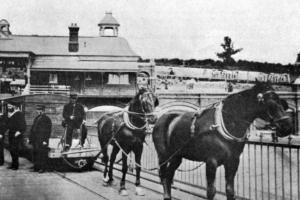
The original Pier with horse drawn car
Southend-on-Sea



Website Info:

Southend-on-Sea’s No 1 History Website! Documenting The Town & The Townspeople
Now Incorporating The Sea Of Change Website


SOUTHEND CITY
Chalkwell ▪ Eastwood ▪ Leigh-on-Sea ▪ Prittlewell ▪ Shoeburyness ▪ Southchurch ▪ Thorpe Bay ▪ Westcliff-on-Sea
































































